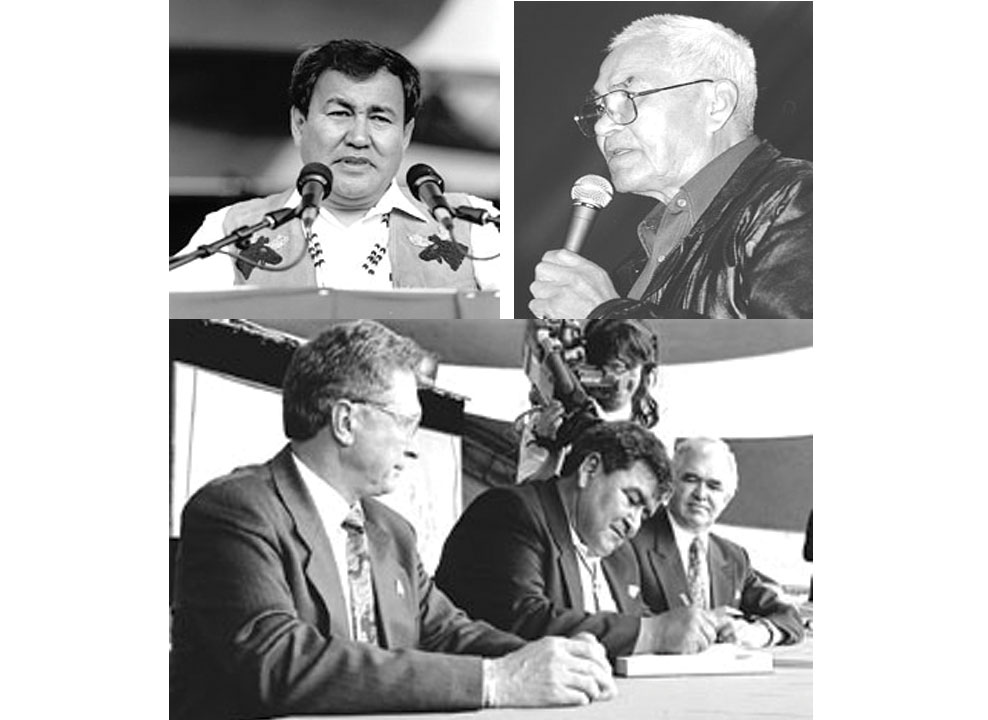Chief Recalls Late Elders Who Blazed Land Claim Trail
The emotional level was at the top of the scale on Saturday as more than 200 people gathered to witness the historic signing of land claim settlements for four Yukon First Nations.
By Whitehorse Star on May 31, 1993
The emotional level was at the top of the scale on Saturday as more than 200 people gathered to witness the historic signing of land claim settlements for four Yukon First Nations.
But none of the speakers was more poignant than Champagne-Aishihik Chief Paul Birckel.
He called the very first organizational meetings in the early 1970s, and the people who were there then, but have died since.
Breaking into a sob just moments into his address, Birckel said earlier Saturday morning he sat and looked at pictures of the late Elijah Smith, Joe Jacquot and Johnny Johns that hung on the wall of the Yukon Indian Centre.
They were all great leaders, he said.
"They are all gone," said the Southern Tutchone chief as emotion broke up his words and interrupted his address.
"I know we are going to do great things. We are going to do great things because we now have the opportunity to do it ourselves, to do it our way and to make our own mistakes."
Documents signed Saturday included the Umbrella Final Agreement. It sets out general provisions for all 14 First Nations and forms the basis for negotiating individual First Nation final agreements.
Also signed were the first First Nation Final agreements and self-government agreements for Champagne-Aishihik, Na-cho Nyak Dun, Teslin Tlingit Council and Vuntut Gwich'in (Old Crow).
The four First Nations were given the go-ahead some two years ago by the other 10 First Nations to break the way. The other 10 still have to negotiate their final agreements.
On settlement land, according to the self-government agreements, the First Nations will have the ability to take control of a variety of responsibilities which are normally the duties of the federal and territorial governments. They are, however, under no obligation to assume any self-governing responsibilities, but can do so at any time.
Included in the long list of areas First Nations can opt to take over are education, justice, environmental protection, child welfare, land use planning and zoning, licensing and regulating business and trade, control or prohibition of public games, and the control of firearms, explosives and weapons.
Where there is conflict between a First Nation law and either a territorial or federal law, however, the First Nation law will override.
Na-cho Nyak Dun Chief Robert Hager wasted no time conveying his thoughts.
"Something Paul forgot to say when he signed that agreement is, 'Hello self-government, goodbye Indian Affairs.' " Hager was one of four chiefs who in 1984 sunk a similar agreement on the verge of being signed because it did not provide for self-government, among other things.
And as the crowd laughed and applauded Hager's words, Indian Affairs Minister Tom Siddon cracked a smile and gave a mock goodbye wave from his chair at the signing table.
"We will be able to build a way of life, to protect our culture and tradition," Hager said,
"We will be able to protect and manage the land our people depend on."
He said he was proud to be one of the four front running chiefs "to do the (trail) blazing for our people."
Teslin Chief Dave Keenan said the agreements are only the beginning, "the seed" from which First Nations will have to grow.
"We have to work together and establish in the government's mind, and I am not so sure it is established now, that we are another order of government," he said.
Teslin elder Sam Johnston was among the delegation that presented in 1973 Together Today for Our Children Tomorrow to then-prime minister Pierre Trudeau. It is the document on which the claim is based.
"This statement here today is partially fulfilled," said Johnston, Speaker of the legislature from 1985 to 1992.
Vuntut Gwich'in Chief Robert Bruce Jr. encouraged the remaining 10 First Nations to work hard on educating their memberships about their individual agreements so that when it's time to vote, they know what's in the deal.
Gwich'in elder Charlie Peter Charlie: "I was worried about what the children were going to do in the future, and now I know there is something good for them, and I am very happy."
Chuck Tobin, Star Reporter

Be the first to comment